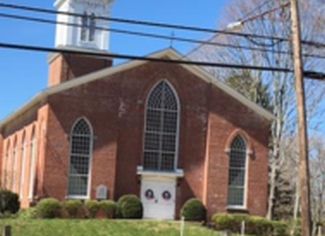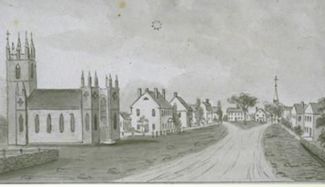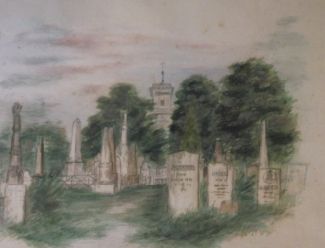30 Church Street -
St. Peters Church

Hebron has some extraordinary examples of religious architecture. St. Peters church built in 1826 is one of them. Compare the 1838 sketch below with what you see today. What are the similarities and what are the differences?

The history of St. Peters goes back almost 100 years before this 1826 building. In 1734, just 26 years after the town was incorporated, residents began to argue about the location of where a new meetinghouse should be located. Its location determined where roads for shipping farm produce would go. Religion may have been a factor, but ultimately economics won. In 1747, an arsonist burned the old meetinghouse (Congregational Church) which stood where the traffic light for Routes 85 and 66 is located. Hebron divided into two groups. Those who supported keeping the meetinghouse in the center remained Congregationalist. Those who wanted to move the meetinghouse further north became Anglicans or Episcopalians. They built a church on Godfrey Hill, north of Hebron Center where the burying ground is located on Route 85. In 1826, the Episcopal Society relocated to the center of Hebron and built this church.
Think about it
What are ways people living in a town can resolve their differences?
Saint Peters’ Graveyard – Rev. Samuel Peters’ grave.

Watercolor of St. Peters Burying Ground by Clara Pendleton 1890
Samuel Peters was the first rector of St. Peters’ church when it was located on Godfrey Hill on Route 85 north of Hebron Center.  He was born in Hebron in 1735. In 1758, Samuel Peters traveled to England and was ordained. This gave him a very worldly perspective while living in a rural town. He was a wealthy individual and owned at least 7 farms in Hebron which he ran as a plantation with the labor of two slave families – Cesar Peters and Pomp Mundo. Burnt Hill Park located on East Street was part of his land holdings which included 600 acres of farmland, horses, cattle, and 4000 fruit trees.
He was born in Hebron in 1735. In 1758, Samuel Peters traveled to England and was ordained. This gave him a very worldly perspective while living in a rural town. He was a wealthy individual and owned at least 7 farms in Hebron which he ran as a plantation with the labor of two slave families – Cesar Peters and Pomp Mundo. Burnt Hill Park located on East Street was part of his land holdings which included 600 acres of farmland, horses, cattle, and 4000 fruit trees.
As an Anglican minister, Rev. Peters was pledged to support the British crown. As events that led up to the Revolution War developed, so did Rev. Peters’ life. In 1774, after the infamous Boston Tea Party destroyed the privately owned tea of the British East India Company, Connecticut towns held meetings to support the people of Boston. Hebron held the first town meeting. Rev. Peters spoke so forcefully about the lawlessness of destroying private property that Hebron voted not to send aid to Boston.
As a result, the Sons of Liberty organized a mob and so terrorized Rev. Peters that he abandoned his property in Hebron and fled to England. He would spend the rest of his life trying to regain his losses. In England, he wrote the first published history of any of the thirteen colonies. His 1781 General History of the State of Connecticut is the foundation of some of Connecticut’s best loved folklore including the Frogs of Windham, the Wethersfield Onion Maidens, and the notorious Blue Laws of Puritan New Haven.
Think about it
Were the Sons of Liberty acting legally when they threatened to tar and feather Rev. Peters to get him to change his political views?
If you had different views than your neighbors, would you abandon all you owned, if you were threatened?
Where to go next
This concludes this part of the tour. You may walk further south for another tour that explores Hebron’s earliest history or return to the traffic light and explore Marjorie Circle and the north part of the Green.
Conclusion
Think About it
If you could choose any building you have seen on your tour to live in which one would you choose and why.
When you get home, imagine that you are living in Hebron in 2123, draw a picture of what looking toward Hebron Center from St. Peter's Church might look like then. Be sure to include street lights, how people travel, signs, and how any of the buildings and landscaping you have seen today would look 100 years from now.





